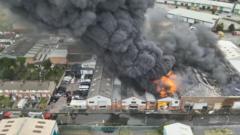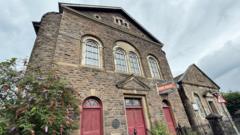How Are Firefighters Battling a Massive Factory Blaze with 20 Tonnes of Tyres?

Firefighters Tackle Massive Blaze at Tyre Factory in West Midlands
In the West Midlands, a significant fire has erupted at a factory housing 20 tonnes of tyres, prompting a swift response from emergency services. More than 70 firefighters have mobilized to combat the blaze at a unit located on Great Bridge Street, situated between Tipton and West Bromwich. The West Midlands Fire Service (WMFS) received the emergency call around 10:40 BST, leading to the dispatch of 17 fire engines, along with various specialized resources to the scene. Fortunately, no casualties have been reported, which is a testament to the efficient evacuation of the premises.
The fire has generated a thick plume of smoke, visible from several miles away, including areas such as Bilston, approximately four miles from the site. This alarming visibility has raised concerns in the community, prompting fire officials to issue warnings urging local residents to steer clear of the area. As firefighters continue their efforts to contain the blaze, they are making significant progress in preventing its spread and bringing the situation under control.
The Scale of the Incident
The fire has occurred in a single-story unit measuring 100 meters by 100 meters. Such large-scale incidents require extensive resources and coordination among various agencies. The WMFS has been supported not only by police and ambulance services but also by specialists, including a drone team, a hydraulic aerial platform, and a high-volume pump team. The comprehensive response highlights the seriousness of the situation and the dedication of the first responders working tirelessly to mitigate the risks associated with the blaze.
Local authorities, including the National Grid, Severn Trent, the Environment Agency, and Sandwell Council, have also sent representatives to the scene. Their presence underscores the multifaceted approach needed to address the potential environmental and safety concerns arising from such a fire. Firefighters are not only focused on extinguishing the flames but also on ensuring that the situation does not escalate further.
Public Safety Measures
With the fire's smoke plume affecting air quality in the vicinity, local residents and businesses have been advised to keep their doors and windows closed. This precaution is vital in preventing smoke inhalation and ensuring the safety of those nearby. The fire service has expressed gratitude to the community for their patience and understanding as crews work diligently to control the situation.
Understanding the Risks of Tyre Fires
Tyre fires present unique challenges for firefighting efforts due to the materials involved. Tyres are made from synthetic rubber, which can ignite easily and burn at extremely high temperatures. In addition, they can produce toxic smoke and hazardous materials when burned, making it critical for firefighters to manage the situation effectively. Here are some key risks associated with tyre fires:
- High Temperatures: Tyres can burn at temperatures exceeding 1,000 degrees Fahrenheit, which poses a severe risk to firefighters.
- Toxic Smoke: The combustion of rubber releases harmful chemicals and heavy metals, endangering both firefighters and nearby residents.
- Fire Spread: Tyres can ignite adjacent materials, leading to rapid fire spread if not contained efficiently.
- Environmental Impact: Runoff from firefighting efforts can contaminate local waterways, emphasizing the need for environmental management.
Historical Context of Tyre Fires
Tyre fires are not an uncommon occurrence, with several notable incidents recorded in the past. Understanding these historical events can provide insights into best practices for managing such emergencies. For example, in 2005, a massive tyre fire in the UK led to extensive environmental damage and long-term consequences for local communities. Such incidents have prompted regulatory changes and increased awareness about fire prevention measures, especially in facilities that store large quantities of tyres.
Firefighting Techniques and Equipment
Firefighters employ various techniques and specialized equipment to combat large-scale fires effectively. In the case of tyre fires, particular methods are utilized to ensure the safety of both the responders and the public. Here’s an overview of the firefighting techniques and equipment commonly used:
- Water Supply: Firefighters often rely on high-volume pumps to deliver large quantities of water to the fire scene. This is crucial for dousing flames and preventing them from spreading.
- Foam Suppression: Firefighting foam can be used to smother flames and reduce the release of toxic smoke. It is particularly effective in dealing with flammable liquids.
- Thermal Imaging Cameras: These devices enable firefighters to detect hotspots and assess the extent of the fire, allowing for more targeted firefighting efforts.
- Controlled Burn Techniques: In some cases, controlled burns may be conducted to eliminate fuel sources and prevent fire spread.
Community Involvement and Awareness
Community involvement plays a vital role in fire prevention and response. Local residents can help by being vigilant and reporting any signs of fire hazards. Educational initiatives and community programs can enhance awareness about fire safety and prevention measures, particularly in areas where tyre storage is prevalent. By fostering a culture of safety, communities can reduce the risks associated with potential fire incidents.
Conclusion
The recent fire at the tyre factory in the West Midlands serves as a stark reminder of the dangers associated with industrial fires and the critical role of firefighters in protecting communities. As the situation continues to develop, the dedication and professionalism of the emergency services are commendable. Residents are encouraged to stay informed and prioritize safety as firefighters work to bring the blaze under control.
FAQs
What caused the fire at the tyre factory in West Midlands?
The cause of the fire is currently under investigation by the authorities. It is essential to determine the factors contributing to such incidents to prevent future occurrences.
How can residents protect themselves during a fire emergency?
Residents should stay indoors, keep windows and doors closed, and follow any instructions from local authorities regarding evacuation or safety measures.
What should businesses do to prevent tyre fires?
Businesses should implement strict safety protocols for the storage and handling of tyres, including regular inspections and adherence to fire codes and regulations.
As this incident unfolds, it raises important questions about fire safety measures and community preparedness. How can we better equip our communities to handle such emergencies in the future? #FireSafety #EmergencyResponse #CommunityAwareness
Published: 2025-07-27 15:35:17 | Category: technology



